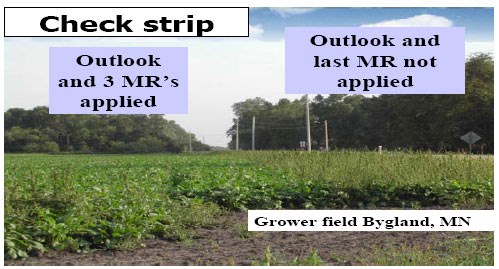484 - Layby Herbicide – Final Weed Control Option
Stand establishment has varied from so very excellent that some fields need to be thinned to only fair or poor on other fields. Crusting after heavy rains, deep planting, cutworms and springtails have reduced stands in some fields. High winds and moving soil always pose a threat to small seedlings. Growers with low plant population fields or “gappy” stands should consider use of a layby herbicide. Fields with soil applied Nortron or Ethotron do not need a layby herbicide application. Nortron should give weed control for at least 10weeks after application.
Layby Herbicide Options For 2006
- Dual Magnum, Outlook and Treflan
Outlook was used on 13% of all acres in 2005, Dual Magnum 1% and Treflan on less than 1%. Weed control was rated good or excellent by 79% of 2005 Outlook users. Weed control from Dual Magnum was rated good or excellent by 50% of growers.
Outlook Use Recommendations for 2006
- Apply after sugarbeets have 4 true leaves
- Use 18 to 21 oz. per acre on medium and fine textured soils
- May split apply Outlook at 7 - 14 day intervals
- Application on two leaf beets increases risk of injury, Table 1
- Outlook can be tank mixed with MR
- Outlook needs less rainfall than Dual to be activated
- Tank mixing with the third MR may be ideal timing
- Never apply layby Outlook over soil applied Nortron
- Rotary hoeing or other incorporation improves performance
- Does not control emerged weeds
Table 1: Risk of Sugarbeet Injury From Outlook at Various Growth Stages. Dr. Alan Dexter, St. Thomas, 1999 *
| Treatment | Sugarbeet Leaf Stage | Sugarbeet Injury - % |
|---|---|---|
| Outlook High Rate | Coty - 2 Leaf | 31 |
| Outlook High Rate | 2 - 4 Leaf | 18 |
| Outlook High Rate | 4 - 8 Leaf | 0 |
* Dual injury would be similar to Outlook at these growth stages.

How to Use Layby Dual Magnum
- Apply at a rate of 1.0 pints/per acre on coarse textured soils, 1.33 pints per acre on medium soils and up to 1.67 pints per acre on fine texture soils
- Sugarbeet plants should have four true leaves to minimize crop injury.
- Apply layby Dual Magnum to four-leaf beets in a tank mix with the microrate.
- Does not control emerged weeds.
- Layby Dual Magnum will require about one-half inch of rain for activation.
- Rainfall needed in 7-10 days to achieve good weed control.
How to Use Layby Treflan:
- Apply at a rate of 1.5 pints/per acre of a 4 lb/gallon formulation (0.75 lb/acre a. i.).
- Apply when sugarbeets are two to six inches tall and well-rooted to withstand incorporation.
- Does not control emerged weeds.
- MUST be incorporated into the soil to avoid herbicide loss.
- Exposed roots should be covered with soil before application. CAUTION - This could increase rhizoctonia in fields with this problem.
Planter Care and Storage Tips
Properly taking care of the planter this spring saves time, effort, and cost of parts as you get ready to plant next year. These tips will help ensure proper planter operation in 2007 and enhance the opportunity to establish optimum plant populations.
Planter off Season Storage
- Clean planter with a pressure washer or high pressure air, it’s especially important to wash off all starter fertilizer to prevent corrosion
- Remove plates and store on a wood dowel hung horizontally
- Remove seed plate doors – do not stack on top of each other, use original boxes
- Release tension on press wheel springs
- Check for missing insecticide spoons or banders
- Make a list of needed repairs and parts
- Mouse proof seed tubes (use fabric softener sheets in each seed hopper)
- Save all new planter plate boxes for warranty use
- Keep track of how many acres are seeded on a set of plates (write the date of purchase in owners manual or 1st year of use on the plates themselves.
Following these steps should eliminate nearly all warped plates, damaged doors and hinges, ruined gaskets and metal corrosion by starter fertilizer. These procedures will extend the life of the planter and seeding mechanism and improve future stands.
When to Use Outlook for Best Value:
- In fields with low stands
- In fields with numerous gaps and skips
- In fields with moderate to severe pigweed pressure
- Best success if applied just ahead of a rain
Thinning High Stands:
Fields with plant population in excess of 225 beets per 100’ of row may benefit from thinning. Increased ease of harvest and improved storage are probable. Contact your agriculturist for assistance with this decision.
